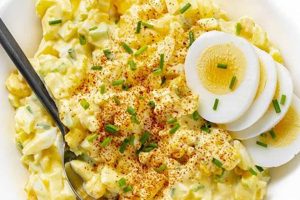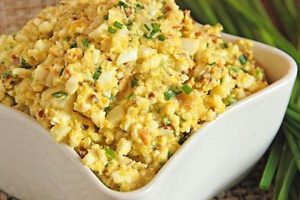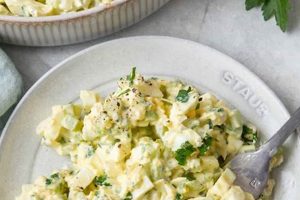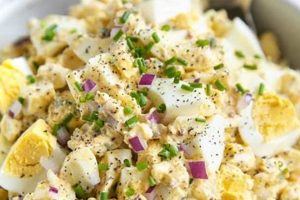A basic preparation involving cooked eggs, mayonnaise, and often other simple ingredients like mustard, salt, and pepper constitutes this classic dish. A typical example combines six hard-boiled eggs, chopped, with approximately one-quarter cup of mayonnaise, a teaspoon of mustard, and salt and pepper to taste. This mixture is then spread on bread for sandwiches, used as a filling for deviled eggs, or enjoyed as a stand-alone salad.
This dish’s popularity stems from its affordability, ease of preparation, and versatility. It serves as a quick and nutritious meal option, utilizing readily available ingredients. Historically, egg salad has been a staple in many cultures, offering a protein-rich food that could be prepared ahead of time and easily transported. Its adaptable nature allows for variations incorporating celery, onion, relish, or other seasonings, reflecting regional and personal preferences.
The following sections will delve into optimal egg cooking methods, explore the impact of mayonnaise choices on flavor and texture, and suggest innovative variations to elevate this timeless dish.
Tips for an Exceptional Egg Salad
Creating a truly satisfying egg salad experience relies on attention to detail. These tips offer guidance on enhancing flavor, texture, and overall quality.
Tip 1: Perfect Hard-Boiled Eggs: Achieving the ideal hard-boiled egg consistency is crucial. Avoid overcooking, which can lead to a dry, rubbery texture and a greenish ring around the yolk. A recommended method involves placing eggs in a saucepan, covering them with cold water, bringing the water to a rolling boil, then removing the pan from heat and letting the eggs sit in the hot water for 10-12 minutes, depending on size. Immediately transferring the eggs to an ice bath stops the cooking process and facilitates peeling.
Tip 2: Mayonnaise Matters: Mayonnaise serves as the foundation of flavor and texture. Experimenting with different types, such as olive oil-based or flavored mayonnaises, can significantly impact the final product. The amount of mayonnaise used also influences the creaminess of the salad. Start with a smaller quantity and gradually add more until the desired consistency is reached.
Tip 3: Seasoning Strategies: Salt and pepper are essential seasonings, but consider adding a pinch of paprika or cayenne pepper for a subtle kick. Fresh herbs like dill or chives can introduce a bright, fresh element.
Tip 4: Texture Considerations: The texture of egg salad can range from chunky to smooth. A coarser chop results in a heartier salad, while finely chopped or mashed eggs create a smoother, more spreadable consistency. Adding finely diced celery or red onion provides a pleasant crunch.
Tip 5: Storage Solutions: Egg salad is best served fresh or chilled promptly after preparation. Store it in an airtight container in the refrigerator for no more than three to five days.
Tip 6: Serving Suggestions: While classic egg salad sandwiches remain a favorite, consider serving the salad on lettuce cups, crackers, or as a filling for deviled eggs or tomatoes for a lighter presentation.
By implementing these tips, one can elevate a basic egg salad into a truly delightful culinary experience.
This concludes the exploration of optimizing egg salad preparation.
1. Hard-boiled Eggs
Hard-boiled eggs constitute the foundational ingredient in a simple egg salad recipe with mayonnaise. Their preparation and quality significantly impact the final dish’s texture, flavor, and overall appeal. Understanding the nuances of hard-boiling eggs is essential for achieving a successful egg salad.
- Cooking Method
Proper cooking technique yields eggs that are easy to peel and possess a tender, not rubbery, texture. Overcooking results in dry, crumbly yolks and an unpleasant sulfurous odor. Recommended methods involve gently boiling eggs for a specific duration, followed by an immediate ice bath to halt the cooking process. This ensures optimal consistency and prevents the formation of a greenish ring around the yolk.
- Freshness
Fresh eggs contribute to both flavor and ease of peeling. Older eggs are more challenging to peel cleanly, often leaving divots and irregularities on the egg white surface. Freshness also impacts the egg’s overall flavor profile, with fresher eggs offering a cleaner taste.
- Yolk Consistency
The yolk’s consistency plays a key role in the final texture of the egg salad. Overcooked yolks become dry and crumbly, resulting in a less creamy and appealing salad. Properly cooked yolks retain a smooth, moist texture that blends seamlessly with the mayonnaise and other ingredients.
- Chopping Technique
The method of chopping the hard-boiled eggs influences the egg salad’s texture. A coarse chop yields a chunkier salad, while finely chopping or mashing the eggs creates a smoother, more spreadable consistency. The desired texture often depends on personal preference and intended use.
The careful consideration of these facets related to hard-boiled eggs directly influences the quality and enjoyment of the simple egg salad recipe with mayonnaise. Mastering the art of hard-boiling eggs elevates this seemingly simple dish to a new level of culinary satisfaction.
2. Mayonnaise (quality matters)
Mayonnaise functions as the binding agent and primary flavor component in a simple egg salad recipe. Its quality directly impacts the final product’s taste, texture, and overall appeal. A high-quality mayonnaise, typically made with real eggs, oil, and vinegar, offers a rich, creamy flavor and smooth texture. Lower-quality alternatives, often containing modified starches and artificial flavors, can result in a bland or overly tangy egg salad with a less desirable consistency. This distinction becomes particularly pronounced in a simple recipe where the mayonnaise’s characteristics are not masked by numerous other ingredients.
Consider the difference between using a freshly made mayonnaise with high-quality olive oil versus a mass-produced mayonnaise containing soybean oil and added sugars. The former imparts a delicate, nuanced flavor and a luxurious mouthfeel, while the latter may contribute a cloying sweetness or an artificial aftertaste. Furthermore, the emulsion stability differs; a high-quality mayonnaise holds its form better, preventing the egg salad from becoming watery or separating over time. This characteristic is crucial for maintaining the desired texture and preventing the bread from becoming soggy in sandwiches.
Understanding the impact of mayonnaise quality allows for informed ingredient selection and contributes significantly to the success of a simple egg salad recipe. Opting for a premium mayonnaise, even in a basic preparation, elevates the dish, delivering a superior sensory experience. The subtle nuances of flavor and texture provided by a quality mayonnaise transform a simple combination of ingredients into a truly satisfying culinary creation.
3. Seasoning (salt and pepper)
Seasoning, primarily with salt and pepper, forms an integral part of a simple egg salad recipe with mayonnaise. While seemingly basic, these seasonings play a crucial role in enhancing the overall flavor profile, balancing the richness of the mayonnaise and eggs, and bringing the dish to life. Careful consideration of seasoning choices distinguishes a bland egg salad from a truly flavorful one.
- Salt’s Impact on Flavor Enhancement
Salt amplifies the inherent flavors of the eggs and other ingredients. It reduces bitterness and enhances sweetness, creating a more balanced and palatable experience. Without sufficient salt, the egg salad may taste flat and underwhelming. However, excessive salt can overpower the delicate flavors of the eggs and mayonnaise, resulting in an unpleasantly salty dish. The correct amount of salt unlocks the full potential of the other ingredients, allowing their flavors to shine.
- Pepper’s Role in Adding Complexity
Pepper introduces a layer of complexity and subtle heat to the egg salad. Freshly ground black pepper offers a more pronounced and aromatic flavor compared to pre-ground pepper. White pepper provides a milder heat and avoids the black specks that some find visually unappealing. The choice between black and white pepper, or a combination of both, depends on personal preference and the desired flavor profile.
- Balancing Richness and Acidity
Salt and pepper help balance the richness of the mayonnaise and the sometimes subtle sulfurous notes of the hard-boiled eggs. The right amount of seasoning prevents the mayonnaise from dominating the flavor profile and ensures a harmonious blend of ingredients. Adding a touch of acidity, such as a squeeze of lemon juice or a dash of vinegar, can further enhance the balance and brightness of the egg salad, complementing the salt and pepper.
- Seasoning Technique and Timing
The timing and technique of seasoning impact the final result. Seasoning the eggs immediately after chopping, while still warm, allows the salt to penetrate more effectively. Adding salt and pepper to the mayonnaise separately before combining it with the eggs ensures even distribution of flavor. Tasting and adjusting the seasoning throughout the preparation process allows for precise control and prevents over- or under-seasoning.
Precise seasoning elevates the simple egg salad recipe with mayonnaise from basic to exceptional. The interplay of salt and pepper enhances the natural flavors of the ingredients, creating a well-balanced and delicious final product. Understanding the nuanced roles of these seasonings allows for a more thoughtful and flavorful culinary experience.
4. Optional additions (mustard, relish)
While mayonnaise and seasonings form the foundation of a simple egg salad recipe, optional additions such as mustard and relish introduce complexity and personalize the flavor profile. These additions, though not strictly essential, offer opportunities to elevate the dish beyond its basic components, catering to individual preferences and creating a more nuanced culinary experience. Understanding their impact on the overall flavor and texture allows for informed choices and a more tailored egg salad creation.
- Mustard’s Tangy Contribution
Mustard introduces a tangy, sharp counterpoint to the richness of the mayonnaise. Different types of mustard, such as yellow mustard, Dijon mustard, or stone-ground mustard, contribute distinct flavor profiles. Yellow mustard offers a mild tang, Dijon adds a more robust and complex flavor, while stone-ground mustard imparts a textured, earthy note. The quantity used influences the overall tanginess; a small amount provides a subtle accent, while a larger quantity creates a more pronounced mustard flavor.
- Relish’s Sweet and Savory Notes
Relish, typically made from chopped pickles, vinegar, and spices, contributes a sweet, tangy, and sometimes spicy element to the egg salad. Sweet pickle relish provides a classic flavor profile, while dill relish adds a herby dimension. The choice of relish influences the overall sweetness and acidity of the egg salad, offering a counterbalance to the richness of the mayonnaise.
- Balancing Flavors and Textures
The interplay between mustard and relish, along with the other ingredients, necessitates careful consideration of flavor balance. Too much mustard can overpower the delicate egg flavor, while an excessive amount of relish can make the salad overly sweet or acidic. The goal is to create a harmonious blend of flavors, where each component complements the others without dominating the palate. The textures of these additions also play a role. The smooth texture of mustard contrasts with the often crunchy texture of relish, adding another layer of complexity to the egg salad.
- Customization and Personalization
Mustard and relish allow for customization based on individual preferences. Some may prefer a strong mustard presence, while others favor a subtle hint of sweetness from relish. Experimenting with different combinations and quantities allows for personalized flavor profiles, transforming a simple egg salad recipe into a bespoke culinary creation. These additions allow for flexibility in catering to different palates and creating unique flavor combinations. Exploring various mustard and relish options opens up a world of possibilities beyond the basic recipe.
The judicious use of optional additions like mustard and relish elevates the simple egg salad recipe with mayonnaise, adding depth and complexity. Understanding the interplay of these ingredients allows for a more thoughtful and personalized culinary experience, transforming a basic dish into something truly special. Careful consideration of flavor profiles and textures allows for a tailored creation that satisfies individual preferences and elevates the enjoyment of this classic dish.
5. Texture (smooth or chunky)
Texture represents a crucial element in a simple egg salad recipe with mayonnaise, significantly influencing the overall sensory experience. The spectrum ranges from perfectly smooth, almost paste-like consistency to a noticeably chunky texture with distinct pieces of egg white and yolk. This textural variation affects not only the mouthfeel but also the visual appeal and even the perceived flavor of the egg salad. Understanding the factors influencing texture allows for deliberate manipulation and creation of a customized culinary experience.
- Chopping Technique
The primary determinant of egg salad texture lies in the method used to process the hard-boiled eggs. A fine chop, achieved through mincing or using a specialized egg slicer, yields a smoother, more uniform texture. Conversely, a coarser chop, achieved by roughly dicing the eggs, produces a chunkier texture with discernible pieces of egg. Mashing the eggs with a fork represents another technique, creating a texture somewhere between smooth and chunky, depending on the degree of mashing. Each method offers a distinct mouthfeel and visual presentation.
- Ingredient Incorporation
The manner in which other ingredients are incorporated also affects the final texture. Finely diced celery or onion adds a subtle crunch, while coarsely chopped ingredients contribute a more pronounced textural contrast. The amount of mayonnaise used also plays a role; more mayonnaise results in a smoother, creamier texture, while less mayonnaise yields a firmer, potentially drier consistency. The interplay of these components contributes to the overall textural complexity.
- Personal Preference and Application
The desired texture often depends on individual preferences and the intended application. A smoother egg salad lends itself well to spreads and sandwich fillings, providing a uniform texture that distributes evenly. A chunkier egg salad, on the other hand, offers a more substantial bite and may be preferred for salads or as a standalone dish. The context in which the egg salad will be consumed influences the optimal textural choice.
- Visual Appeal and Flavor Perception
Texture impacts not only the mouthfeel but also the visual appeal and perceived flavor of the egg salad. A smooth egg salad presents a uniform appearance, while a chunky egg salad offers visual interest with discernible pieces of egg and other ingredients. The texture can also influence how flavors are perceived; a smoother texture may lead to a more homogenous flavor experience, while a chunkier texture allows for distinct bursts of flavor from individual components.
Controlling the texture through deliberate chopping techniques, ingredient incorporation, and consideration of personal preferences and intended use elevates the simple egg salad recipe with mayonnaise. Texture represents an essential dimension of culinary creation, transforming a basic dish into a customized sensory experience. By understanding the interplay of these factors, one can achieve the desired texture and optimize the enjoyment of this classic dish.
6. Bread or crackers
Bread and crackers serve as the quintessential delivery vehicles for simple egg salad with mayonnaise, transforming the mixture into a convenient and satisfying meal or snack. The choice between bread and crackers significantly influences the overall sensory experience, impacting texture, flavor, and portability. This seemingly simple decision carries practical implications for enjoyment and dictates how the egg salad interacts with its carrier.
Bread, with its soft, yielding texture, offers a neutral backdrop that allows the flavors of the egg salad to take center stage. White bread provides a classic pairing, while whole wheat or multigrain bread introduces subtle nutty or earthy notes. The bread’s absorbency necessitates consideration of the egg salad’s moisture content; a wetter egg salad may require a sturdier bread to prevent sogginess. Sandwiches, a ubiquitous application of this combination, benefit from bread’s structural integrity, offering a convenient handheld meal. The bread’s thickness and size further influence portion control and overall presentation. For example, a thinly sliced baguette offers a delicate, crusty counterpoint, while a thicker slice of sourdough provides a more substantial and flavorful experience.
Crackers, in contrast to bread, offer a crisp, crunchy texture that provides textural contrast to the creamy egg salad. The variety of cracker flavors, from plain salted to buttery or herbed, introduces additional complexity. The cracker’s size and shape dictate portioning and presentation, influencing the overall aesthetic. For example, small, round crackers serve as elegant platforms for appetizers, while larger, rectangular crackers offer a more substantial base for a light meal. Crackers also lend themselves to portability, making them a practical choice for picnics or packed lunches. Unlike bread, crackers are less susceptible to sogginess, maintaining their crispness even with a wetter egg salad. This characteristic makes them ideal for situations where immediate consumption is not guaranteed. Selecting the appropriate cracker, considering factors like flavor, size, and shape, optimizes the pairing and elevates the enjoyment of the egg salad. The cracker’s ability to maintain its texture and structural integrity even with a moister egg salad expands the possibilities for presentation and consumption.
The choice between bread and crackers for serving simple egg salad with mayonnaise depends on individual preferences, context, and desired outcome. Each option presents unique textural and practical considerations, impacting the overall sensory experience and influencing portability and presentation. Understanding these nuances allows for informed decisions and optimization of the egg salad experience. Careful selection of the carrier, whether bread or crackers, ensures a harmonious pairing and elevates this simple dish to a new level of culinary satisfaction.
7. Fresh preparation
Fresh preparation represents a cornerstone of a successful simple egg salad recipe with mayonnaise. This prioritization stems directly from the inherent qualities of the core ingredients and their susceptibility to deterioration. Freshly cooked eggs, crucial for optimal texture and flavor, rapidly decline in quality upon storage, impacting both palatability and food safety. Mayonnaise, an emulsion prone to separation and bacterial growth, also benefits significantly from immediate use after preparation or opening a freshly manufactured container. The combined perishability of these components necessitates an emphasis on freshness for a truly satisfying and safe culinary experience.
Consider the difference between using freshly cooked, still-warm, hard-boiled eggs versus refrigerated eggs cooked several days prior. The former peel more easily, offer a superior, creamier yolk texture, and contribute a cleaner flavor profile to the final product. Similarly, fresh mayonnaise exhibits a smoother, more stable emulsion and lacks the off-flavors that can develop in older mayonnaise due to oxidation or bacterial growth. These distinctions become particularly pronounced in a simple recipe where the inherent flavors of the ingredients are not masked by strong spices or other additions. The impact of fresh preparation manifests as a noticeable improvement in overall quality, evidenced by a brighter flavor, more appealing texture, and reduced risk of foodborne illness. For instance, an egg salad prepared with week-old eggs and opened mayonnaise stored improperly might exhibit a watery consistency, an off-putting sulfurous aroma, and potentially harbor harmful bacteria, whereas a freshly prepared version boasts a creamy texture, a clean egg flavor, and minimizes safety risks.
Prioritizing fresh preparation, while seemingly obvious, underscores a fundamental principle of culinary practice, particularly with recipes reliant on delicate ingredients. This understanding directly translates to a superior sensory experience and mitigates potential health risks. The commitment to freshness becomes a defining factor in achieving the full potential of a simple egg salad recipe with mayonnaise, transforming it from a basic combination of ingredients into a truly enjoyable and safe culinary creation. Disregarding this principle can compromise both quality and safety, underscoring the practical significance of fresh preparation in maximizing the enjoyment and minimizing the risks associated with this classic dish.
Frequently Asked Questions
This section addresses common inquiries regarding the preparation and enjoyment of egg salad made with mayonnaise. Clarity on these points ensures consistent, high-quality results and promotes safe handling practices.
Question 1: How long can egg salad with mayonnaise be safely stored?
Refrigeration at or below 40F (4C) is crucial. Consume within three to five days for optimal quality and safety. Beyond this timeframe, the risk of bacterial growth increases significantly.
Question 2: What are signs that egg salad has spoiled?
Discard egg salad exhibiting any off-putting odor, discoloration, or unusual texture. A sour smell, discoloration of the yolks, or a slimy texture indicates spoilage. When in doubt, err on the side of caution and discard the product.
Question 3: Can alternative ingredients be substituted for mayonnaise?
While mayonnaise provides the classic creamy texture and flavor, substitutions like plain Greek yogurt, avocado, or hummus offer healthier alternatives. However, these substitutions will alter the traditional flavor profile and may require adjustments to seasonings or other ingredients.
Question 4: What are effective methods for preventing a watery egg salad?
Ensure eggs are thoroughly drained after cooking and cooling. Overcooking can also contribute to excess moisture. Adjust the amount of mayonnaise gradually to achieve the desired consistency, avoiding an excess that can thin the mixture.
Question 5: How can one enhance the flavor of a basic egg salad recipe?
Fresh herbs, such as dill, chives, or parsley, elevate the flavor profile. Spices like paprika, cayenne pepper, or curry powder introduce complexity. Incorporating finely diced vegetables, such as celery, red onion, or bell pepper, adds textural and flavor dimensions.
Question 6: Is it safe to use store-bought hard-boiled eggs for egg salad?
Store-bought hard-boiled eggs offer convenience. However, they often possess a firmer, drier texture compared to freshly cooked eggs. This can impact the final texture of the egg salad. Check expiration dates carefully and ensure proper refrigeration.
Adherence to safe handling practices and a thorough understanding of ingredient interactions contribute to a safe and enjoyable egg salad experience.
This concludes the frequently asked questions section.
Simple Egg Salad Recipe with Mayonnaise
This exploration has delved into the nuances of the simple egg salad recipe with mayonnaise, highlighting the crucial role of ingredient quality, preparation techniques, and optional additions in shaping the final product. From the optimal cooking of hard-boiled eggs to the selection of mayonnaise and the judicious use of seasonings, each element contributes to the overall sensory experience. The potential for textural variation, achieved through chopping techniques, and the choice of accompanying bread or crackers further personalize this versatile dish. An emphasis on fresh preparation underscores the importance of food safety and optimal flavor.
The seemingly simple egg salad recipe with mayonnaise offers a canvas for culinary creativity. Understanding the interplay of ingredients and techniques empowers one to elevate this classic dish beyond its basic components, transforming it into a personalized culinary expression. This knowledge fosters appreciation for the subtle complexities within this timeless recipe, encouraging continued exploration and enjoyment of its adaptable nature.






